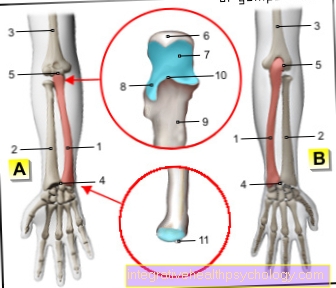Thalamus
introduction
The thalamus represents the largest structure of the diencephalon and is located once in each hemisphere. These are each a bean-shaped structure that is connected to one another by a kind of bridge. In addition to the thalamus, the diencephalon also includes other anatomical structures such as the hypothalamus with the pituitary gland, the epithalamus with the epiphysis and the subthalamus. The thalamus is in close contact with the cerebrum via certain pathways. Information that the body receives via the ears, eyes, skin or the position of its own body in space initially flows to the thalamus.

Anatomy and function
The various stimuli that are supposed to penetrate into consciousness are switched in the thalamic nuclei and then passed on. A distinction is made between specific and unspecific thalamic nuclei, and each of them absorb certain information and pass it on to different areas of the cerebrum. The specific thalamic nuclei are again divided into an anterior, middle and posterior group. The anterior lateral core group (nucleus ventralis anterolateralis) mainly processes motor information, i.e. signals for movement of the body. This is followed by anterior posterior nuclei (nucleus vertralis posterior). These pick up signals of deep sensitivity and the sense of touch. The deep sensitivity describes information from the muscles, the tendons and the joints. It is used to constantly record and adjust the position of the joints in space. A process that is necessary for our brain to plan and execute movements.
As a kind of first filter station, this information is preprocessed and sorted out. Information that is important, i.e. that should be consciously perceived by humans, is passed on from the thalamus to the corresponding regions in the cerebrum. Because of this information processing, the thalamus is often also called "Gateway to Consciousness" designated. This type of switching point filters out unimportant information so that people only perceive the important and essential in a situation. At the same time, the brain is protected from overstimulation.
The anterior thalamic nuclei (Nuclei anteriores thalami) pick up important signals for functions such as learning, memory, emotions, food intake and digestion. These services are summarized as a limbic system to which various structures are distributed in the cerebrum. The middle thalamic nuclei (Nuclei mediales thalami) relay information relating to cognitive abilities such as thinking and are particularly well connected to the anterior cerebral areas. The specific cores also include two special areas, which are called lateral and medial knee cusps (Corpus geniculatum laterale and mediale).
The side part belongs to Visual pathway. This receives the stimuli from the visual field, more precisely from the retina of the eyes. They are processed and forwarded to the visual cortex in the cerebrum, which is located at the back of the head, and processed into an image. The medial knee cusps are part of the Audio track and accordingly transmit the stimuli that we perceive with the ears to the corresponding areas in the cerebrum. Last heard of that pillow-shaped pulvinar, in English 'pillow', to the specific cores. This is responsible for the further processing of perception, memory and language.
The unspecific thalamic nuclei are not referred to with proper names. This includes an intermediate group (nuclei intralaminares), which is said to be important for the control of consciousness. The middle kernels are also like some specific kernels with the limbic system connected. They also contain a portion of the olfactory tract, although the olfactory tract is the only exception and does not reach the cerebrum via the thalamic nuclei.
Thalamic infarction
At a Thalamic infarction is it a stroke in the thalamus, the largest structure of the diencephalon. The cause of this infarction is an occlusion of the supplying vessels, which means that the thalamus is supplied with less blood. The cells can then die and acute neurological complaints arise. Depending on which side of the thalamus is affected, symptoms such as sensory disturbances appear on the other, i.e. contralateral half of the body. Complete paralysis of the muscles on one side of the body can also occur. This is called in medicine Hemiplegia and is a typical clinical picture after a stroke.
The damage to the thalamus can cause memory impairment in the form of Amnesias (Gaps in memory) occur. Since the thalamus has various functions like that Think and Learn different symptoms can occur depending on the damaged area. Affected people also suffered from disturbances in their visual attention and learning.
Also Changes in nature of the patient can occur such as Listlessness but also aggressive behavior. Psychological changes such as reduced resilience and fatigue are not uncommon in thalamic infarctions, which is why neuropsychological care can be useful. Furthermore, there can be increased reflexes and excessive movements. A stroke represents a Emergency situation which should be acted upon quickly, so the emergency doctor should be called in case of suspicion.
Thalamic hemorrhage
At a Thalamic hemorrhage it is a bleeding that occurs in the thalamus in the diencephalon. It is often caused by high blood pressure, which the patient calls hypertension. Another but rarer cause of the bleeding can be Vascular malformations be. Patients with risk factors such as obesity and the consumption of nicotine are particularly at risk. The patients suffer from Sensory disturbances and Pain in the other half of the body. Which side is affected by the deficits depends on which side of the thalamus is affected by bleeding.
Severe impairments can also take the form of a Hemiplegia (Hemiparesis) occur. Accordingly, the patient can no longer move his arms and legs on this side. These complaints can be reduced. Furthermore are Impaired consciousness and a vertical Eye paralysis (Paresis) typical of a thalamic hemorrhage. In the case of vertical paralysis, the patient can no longer move his eyes quickly up and down. Using imaging tests like that Computed tomography (CT) and the Magnetic resonance imaging (MRI) bleeding and its extent in the diencephalon can be diagnosed. The subsequent treatment depends on the extent of the bleeding and the cause. The bleeding is usually stopped with medication and antihypertensive medication is also part of the therapy. Further measures depend on the patient's condition and symptoms.












.jpg)
















